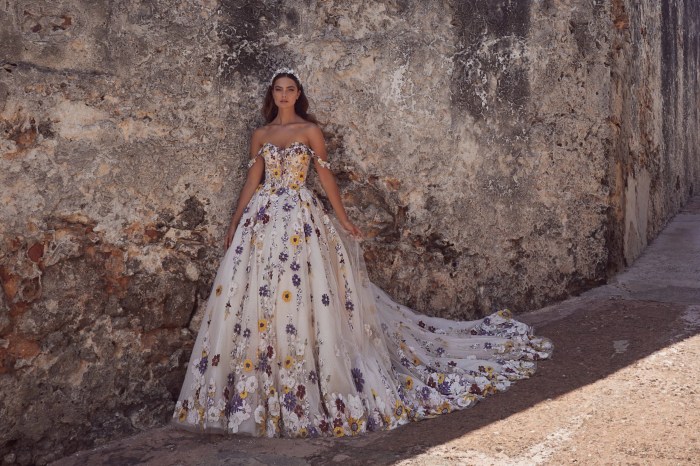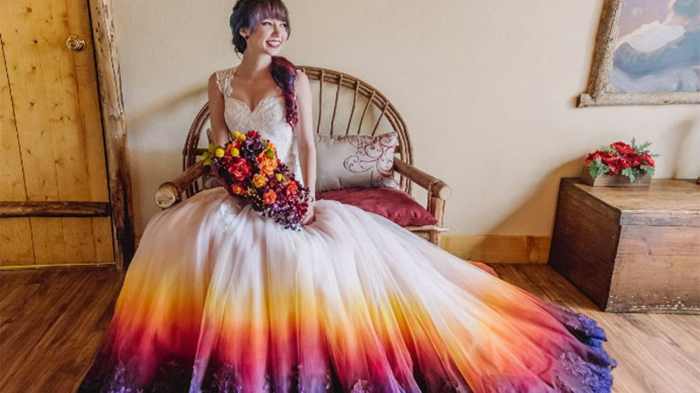Wedding Dresses with Colored Flowers
Popular Flower Choices and Design Techniques for Wedding Dresses
Wedding dresses with colored flowers – Choosing the right floral embellishments for a wedding dress is a crucial step in creating a cohesive and memorable bridal look. The selection of flowers, their colors, and how they are incorporated into the design significantly impact the overall aesthetic and mood. This section explores popular flower choices, color combinations, design techniques, and seasonal considerations to help brides make informed decisions.
Wedding dresses adorned with colorful floral appliques or bouquets offer a vibrant and personalized touch. For brides seeking affordable options, exploring stores offering wedding dresses san Antonio TX cheap can be a great starting point. Remember, even budget-friendly gowns can be beautifully enhanced with the addition of colorful flowers, creating a stunning and unique look.
Popular Flower Choices for Wedding Dresses
Several flower colors consistently rank high in popularity for wedding dress embellishments. These choices often reflect symbolic meanings associated with love, purity, and new beginnings. The choice of fabric also plays a vital role in achieving the desired look and feel.
- Ivory/White: Symbolizing purity, innocence, and new beginnings. Often used in classic and traditional designs.
- Blush Pink: Representing romance, femininity, and sweetness. A popular choice for romantic and ethereal styles.
- Light Blue: Associated with serenity, tranquility, and loyalty. Creates a calming and elegant effect.
- Soft Yellow: Symbolizing happiness, joy, and friendship. Adds a cheerful and vibrant touch.
- Lavender/Purple: Representing royalty, luxury, and sophistication. Adds a touch of elegance and mystery.
Common fabrics used for embroidered or appliquéd floral designs include silk, organza, tulle, lace, and satin. Each fabric offers a unique texture and drape, influencing the overall appearance of the floral details.
Wedding Dress Silhouette Designs with Floral Patterns, Wedding dresses with colored flowers

Source: kleinfeldbridal.com
| Design 1 | Design 2 | Design 3 |
|---|---|---|
| A-line silhouette with embroidered blush pink roses and ivory leaves. The delicate embroidery adds a romantic touch to the classic A-line shape. | Mermaid silhouette with appliquéd light blue forget-me-nots and pearl accents. The structured silhouette is softened by the delicate floral details. | Ballgown silhouette with 3D floral arrangement of soft yellow sunflowers and green foliage. The bold floral arrangement adds a dramatic touch to the voluminous skirt. |
Color Combinations and Their Effects on Wedding Dress Aesthetics
The chosen color palette significantly influences the overall mood and aesthetic of a wedding dress. Different palettes evoke various feelings and suit different styles.
Pastel palettes, for example, create a soft, romantic, and ethereal feel, while bold color palettes make a statement and are perfect for brides who want to stand out. Monochromatic palettes, using variations of a single color, offer a sophisticated and elegant look.
Warm vs. Cool-Toned Flowers on Wedding Dresses

Source: s-nbcnews.com
- Warm-toned flowers (reds, oranges, yellows): Convey energy, vibrancy, and warmth. They are ideal for autumn or summer weddings and brides with cool undertones.
- Cool-toned flowers (blues, purples, greens): Project calmness, serenity, and sophistication. They suit spring or winter weddings and brides with warm undertones.
The color of the flowers should complement or contrast with the bride’s skin tone and hair color. For example, warm-toned flowers might enhance a bride with cool undertones, while cool-toned flowers could complement warm undertones.
Floral Design Techniques and Placement on Wedding Dresses
Several methods exist for incorporating colored flowers onto a wedding dress, each offering a unique visual effect and level of intricacy.
| Embroidery | Appliqué | 3D Floral Arrangements |
|---|---|---|
| Intricate embroidered floral patterns create a delicate and romantic look, often seen on gowns with lighter fabrics. The design can be customized to fit the bride’s personal style and preferences. | Appliqué involves attaching fabric flowers to the dress, offering a more three-dimensional effect. This technique allows for a variety of textures and sizes of floral elements. | Three-dimensional floral arrangements add a dramatic and luxurious touch. These arrangements can range from small clusters to large, cascading designs, creating a truly unique and eye-catching look. |
Strategic placement of floral designs enhances the silhouette and overall visual appeal. For instance, clustering flowers at the waist can emphasize the narrowest part of the body, while scattering them across the skirt creates a more whimsical look. Linear arrangements along the bodice or train add a touch of elegance.
Scattered, clustered, and linear arrangements create different visual effects. Scattered arrangements offer a more relaxed and whimsical feel, clustered arrangements create focal points, and linear arrangements provide a sense of structure and elegance.
Wedding Dress Styles and Floral Integration
Different wedding dress styles lend themselves to various floral designs and color palettes.
- A-line: Versatile style that accommodates various floral designs and colors. Delicate embroidery or scattered floral appliqués work well.
- Ball gown: Grand style that can handle bold floral arrangements or intricate embroidery. Consider large-scale floral motifs or 3D elements.
- Mermaid: Structured silhouette that benefits from strategically placed floral designs. Appliqué or embroidery along the fitted bodice or train enhances the shape.
- Sheath: Sleek style that complements minimalist floral designs. Delicate embroidery or small appliqués work best.
- Empire waist: Romantic style that pairs well with delicate floral details around the bust or flowing down the skirt. Consider pastel colors or light embroidery.
The scale and size of the floral designs should be adjusted based on the chosen wedding dress style and the bride’s body type. Smaller, delicate designs suit petite brides and simpler dress styles, while larger, bolder designs work well with more dramatic styles and taller brides.
Colored flowers can be integrated into various dress accessories:
- Veil: Delicate embroidery or appliqués on the veil can complement the dress’s floral details.
- Belt: A floral-embellished belt adds a pop of color and texture to the waist.
- Headpiece: Floral crowns or hairpins create a romantic and whimsical touch.
Seasonal Considerations for Floral Choices
Seasonal availability impacts the choice of flowers and their cost. Certain flowers are more readily available and less expensive during specific seasons.
- Spring: Light and pastel colors such as tulips, daffodils, and hydrangeas.
- Summer: Vibrant colors like sunflowers, roses, and peonies.
- Autumn: Rich colors such as dahlias, asters, and chrysanthemums.
- Winter: Elegant and understated colors such as amaryllis, poinsettias, and winter berries.
Seasonal availability also affects cost. Flowers that are out of season will generally be more expensive due to import costs and limited supply.
Alternative materials that mimic the look of flowers for off-season weddings include high-quality silk flowers, fabric flowers, beads, sequins, and crystals.
FAQ Overview: Wedding Dresses With Colored Flowers
Can I use artificial flowers on my wedding dress?
Yes, artificial flowers provide a cost-effective and readily available alternative, especially for off-season weddings or specific flower choices.
How do I care for a wedding dress with floral embellishments?
Dry cleaning is recommended to preserve the delicate floral details. Always check with your dry cleaner regarding specific instructions for your dress’s fabric and embellishments.
Are there any ethical considerations regarding the flowers used?
Consider sourcing locally grown, sustainably farmed flowers or opting for artificial alternatives to minimize environmental impact.
What if my chosen flowers are out of season?
Preserved flowers or high-quality silk alternatives can mimic the look of fresh blooms while ensuring availability year-round.



















